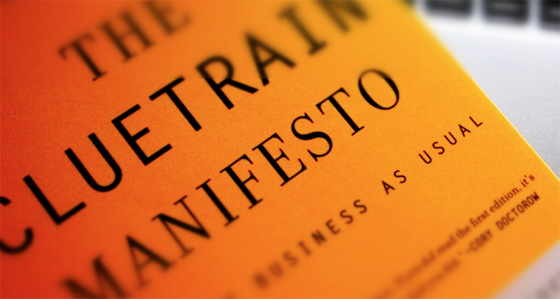WHAT IS THE CLUETRAIN MANIFESTO?
The Cluetrain Manifesto is to be understood as a „train of notion“ and is to be considered a prophecy of the Digital Age. It was already written in 1999 by tech-thinkers Rick Levine, Christopher Locke, Doc Searls, and David Weinberger. Like Martin Luther, the collection of the Manifesto includes 95 theses and is about the relations between companies and their customers in the age of the rising Internet. 22 years ago, the internet was something new – Nobody knew what was going on and the world was facing uncertainty. Today, we are still facing the same challenges. Same same but different. However, the relevance of the Manifesto is now more important than ever.
“Slowly at first, a new kind of conversation was beginning to emerge, but it would achieve global reach with astonishing speed.” (cluetrain.com)
Although there have been tremendous changes since the Dotcom burst, a huge number of websites, apps, social media networks and other digital possibilities have shifted our whole world into the digital direction.
But now let’s finally take a look at the first five theses and see what they are all about:
→ Markets are conversations.
→ Markets consist of human beings, not demographic sectors.
→ Conversations among human beings sound human. They are conducted in a human voice.
→ Whether delivering information, opinions, perspectives, dissenting arguments or humorous asides, the human voice is typically open, natural, uncontrived.
→ People recognize each other as such from the sound of this voice.
FOOD FOR THOUGHTS
We are entering a world of conversational marketing and commerce. A human voice could also belong to a system not only to a human (Voice AI). Due to new technology and AI there will be new hybrid models in the future.
FURTHER THOUGHTS
The first five theses describe a world of information in which the web and social networks have changed the structures of power between companies and customers. A world in which users decide what kind of information and content is widespread. Social networks open up unprecedented communication opportunities. We are experiencing a change from traditional one-way communication to user-generated dialog. Users generate their knowledge and experience in order to communicate.
This knowledge is stored in people’s minds; as empirical knowledge, social knowledge, tacit knowledge – it’s about educated decision making. Just check out the EDM phenomenon.
How do you communicate nowadays?
Do you use traditional ways, or did you hop on the train?
THE BOOK

Image by tinytalk
